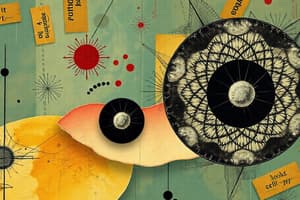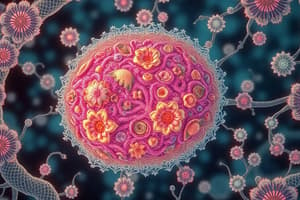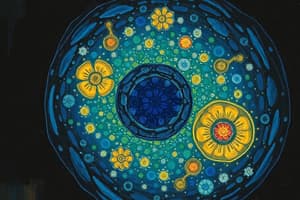Podcast
Questions and Answers
Which of the following distinguishes eukaryotic cells from prokaryotic cells?
Which of the following distinguishes eukaryotic cells from prokaryotic cells?
- Presence of a nucleus. (correct)
- Presence of cytoplasm.
- Presence of a cell membrane.
- Presence of ribosomes.
Which organelle is primarily responsible for generating ATP through cellular respiration?
Which organelle is primarily responsible for generating ATP through cellular respiration?
- Endoplasmic reticulum.
- Golgi apparatus.
- Mitochondria. (correct)
- Lysosomes.
What role does the Golgi apparatus play in a eukaryotic cell?
What role does the Golgi apparatus play in a eukaryotic cell?
- Generating ATP.
- Processing and packaging proteins and lipids. (correct)
- Synthesizing proteins.
- Breaking down waste materials.
In cell signaling, what is the role of a receptor protein?
In cell signaling, what is the role of a receptor protein?
Which of the following best describes the function of lysosomes?
Which of the following best describes the function of lysosomes?
During which phase of the cell cycle does the cell grow and prepare for division?
During which phase of the cell cycle does the cell grow and prepare for division?
Which of the following is NOT a typical function of proteins embedded in the cell membrane?
Which of the following is NOT a typical function of proteins embedded in the cell membrane?
What is the primary function of the nucleolus inside the nucleus?
What is the primary function of the nucleolus inside the nucleus?
Which type of cell communication involves the use of hormones?
Which type of cell communication involves the use of hormones?
What is the main function of the smooth endoplasmic reticulum?
What is the main function of the smooth endoplasmic reticulum?
Flashcards
What is Biology?
What is Biology?
The scientific study of life, including structure, function, growth, origin, evolution, and distribution of living organisms.
What is Cell Biology?
What is Cell Biology?
A branch of biology focusing on the study of cells, including their structure, function, and behavior at microscopic and molecular levels.
What are Cells?
What are Cells?
Basic structural and functional units of all known living organisms, existing in two main types: prokaryotic and eukaryotic.
What are Prokaryotic Cells?
What are Prokaryotic Cells?
Signup and view all the flashcards
What are Eukaryotic Cells?
What are Eukaryotic Cells?
Signup and view all the flashcards
What is the Cell Membrane?
What is the Cell Membrane?
Signup and view all the flashcards
What is the Nucleus?
What is the Nucleus?
Signup and view all the flashcards
What are Mitochondria?
What are Mitochondria?
Signup and view all the flashcards
What is the Endoplasmic Reticulum (ER)?
What is the Endoplasmic Reticulum (ER)?
Signup and view all the flashcards
What is the Golgi Apparatus?
What is the Golgi Apparatus?
Signup and view all the flashcards
Study Notes
- Scientific study of life is Biology
- Biology studies living organisms' structures, functions, growth, origins, evolution, and distribution.
- Cells are the basic unit of life
- Genes are the basic unit of heredity
- Evolution is the engine that propels the creation and extinction of species
- Living organisms share characteristics like organization, metabolism, homeostasis, growth, reproduction, response to stimuli, and adaptation through evolution.
Cell Biology
- The study of cells is cell biology
- Cell biology focuses on the structure, function, and behavior of cells Studying cells at the microscopic and molecular level is cell biology
- Cell signaling pathways, cell cycle, and how cells interact with their environment are key to cell biology
- Genetics, molecular biology, and biochemistry are related to cell biology
Cell Structure
- Cells are the basic structural and functional units of life
- Prokaryotic and eukaryotic cells are the 2 main types of cells
- Prokaryotic cells lack a nucleus & membrane-bound organelles
- Eukaryotic cells have a nucleus and other membrane-bound organelles like mitochondria, endoplasmic reticulum, and the Golgi apparatus
Prokaryotic Cells
- Prokaryotic cells are generally smaller and simpler than eukaryotic cells
- Bacteria and Archaea are prokaryotic cells
- DNA genetic material in prokaryotic cells located in the cytoplasm in a region called the nucleoid
- Cell walls provide structure and protection for prokaryotic cells
- Capsules are sticky outer layers on many prokaryotic cells to adhere to surfaces or evade immune responses
- Flagella for movement or pili for attachment are features of some prokaryotic cells
Eukaryotic Cells
- Eukaryotic cells are more complex and organized than prokaryotic cells
- Protists, fungi, plants, and animals contain Eukaryotic cells
- A nucleus containing the cell's DNA is the defining feature of eukaryotic cells
- Eukaryotic cells contain a variety of membrane-bound organelles performing specific functions:
- Mitochondria for energy production
- Endoplasmic reticulum for protein and lipid synthesis
- Golgi apparatus for processing and packaging proteins
- Lysosomes for waste disposal
- Chloroplasts (in plant cells) for photosynthesis
- A cytoskeleton provides structural support and facilitates cell movement in Eukaryotic cells
Cell Membrane
- The cell membrane (plasma membrane) is a selectively permeable barrier around all cells
- It is made of a lipid bilayer with embedded proteins
- The lipid bilayer is composed of phospholipids
- With hydrophilic (water-attracting) head
- Hydrophobic (water-repelling) tails
- Proteins in the cell membrane
- Act as channels/carriers to transport molecules
- Serve as receptors for signaling molecules
- Function as enzymes
- Provide structural support
- The cell membrane regulates the movement of substances in/out of the cell
- Cell membrane plays a role in cell signaling and cell-to-cell communication
Nucleus
- The nucleus is the control center of the eukaryotic cell
- The cell's DNA is in the nucleus and organized into chromosomes
- A nuclear envelope surrounds the nucleus with a double membrane
- The nuclear envelope has pores that regulate molecule movement between the nucleus and the cytoplasm
- The nucleolus within the nucleus is the site of ribosome synthesis
Mitochondria
- Mitochondria are the powerhouses of the cell
- They produce ATP (adenosine triphosphate) through cellular respiration.
- Mitochondria have a double membrane, with the inner membrane folded into cristae
- Cristae increase surface area for ATP production
- Mitochondria have their own DNA and ribosomes suggesting they evolved from endosymbiotic bacteria
Endoplasmic Reticulum (ER)
- Endoplasmic reticulum (ER) is a network of membranes throughout the cytoplasm of eukaryotic cells
- Rough ER and smooth ER are the 2 types
- Rough ER is covered with ribosomes and is involved in protein synthesis and modification
- Smooth ER lacks ribosomes and is involved in lipid synthesis, detoxification, and calcium storage
Golgi Apparatus
- The Golgi apparatus processes and packages proteins and lipids.
- It consists of cisternae, which are flattened, membrane-bound sacs
- Proteins and lipids from the ER are transported to the Golgi apparatus in vesicles
- Within the Golgi apparatus, they are modified, sorted, and packaged into new vesicles for delivery to other parts of the cell or for secretion
Lysosomes
- Lysosomes contain digestive enzymes
- They break down waste materials and cellular debris
- Lysosomes fuse with vesicles containing the materials to be digested
- Enzymes within the lysosome break down the materials into smaller molecules to be reused by the cell
Cell Signaling
- Cell signaling is communication between cells
- Cells communicate through
- Direct contact
- Releasing signaling molecules that travel to other cells
- Signaling molecules bind to receptors on the surface of target cells, triggering intracellular events
- These events can lead to changes in gene expression, cell metabolism, or cell behavior
- Cell signaling coordinates activities of cells in multicellular organisms
Cell Cycle
- The cell cycle is the series of events in a cell leading to division and duplication
- Interphase and mitosis are the 2 main phases
- Interphase is the period the cell cycle grows & prepares for division
- Mitosis is the process of nuclear division, separating chromosomes into 2 identical sets
- Cytokinesis, division of the cytoplasm, follows mitosis
- The cell cycle is tightly regulated to divide properly
- Disruptions in the cell cycle can lead to uncontrolled cell growth and cancer
Cell Communication
- Cells communicate in a number of ways:
- Direct contact: gap junctions
- Local signaling: growth factors or neurotransmitters
- Long-distance signaling: hormones
- Reception, transduction, and response, all involve cell communication
Cell Metabolism
- Cell metabolism encompasses all chemical processes within a cell
- These processes:
- Catabolism: complex molecules broken down into simpler ones, releasing energy
- Anabolism: complex molecules synthesized from simpler ones, requiring energy
- Enzymes regulate metabolic reactions
- ATP is the main energy currency of the cell
Studying That Suits You
Use AI to generate personalized quizzes and flashcards to suit your learning preferences.




